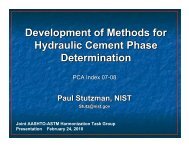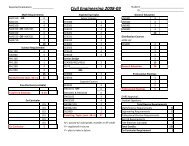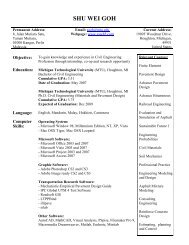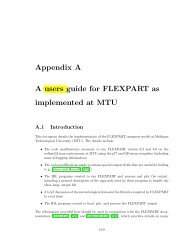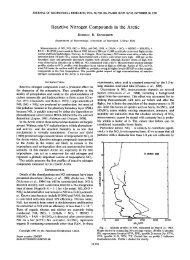Evaluation of Septic Tank and Subsurface Wetland for
Evaluation of Septic Tank and Subsurface Wetland for
Evaluation of Septic Tank and Subsurface Wetland for
You also want an ePaper? Increase the reach of your titles
YUMPU automatically turns print PDFs into web optimized ePapers that Google loves.
Critical design parameters <strong>for</strong> septic tanks include proper piping, tank volume <strong>and</strong> tank<br />
dimension. A sanitary tee pipe fitting on the inlet directs the influent downward to<br />
reduce short circuiting. A sanitary tee on the outlet prevents floating scum from exiting<br />
<strong>and</strong> clogging the wetl<strong>and</strong> or tile field receiving the effluent. For a two-chamber tank, the<br />
chamber dividing wall allows liquid free <strong>of</strong> scum <strong>and</strong> sludge to pass from the first<br />
chamber to the second chamber, <strong>and</strong> it has ventilation above the liquid level to allow<br />
pressure equalization between the chambers. Sufficient tank volume is necessary so that<br />
after the maximum expected volume <strong>of</strong> sludge <strong>and</strong> scum has accumulated, the tank has a<br />
minimum <strong>of</strong> 24-hour fluid retention time <strong>for</strong> particulate settling (USEPA, 2000). Rules<br />
<strong>of</strong> thumb <strong>for</strong> septic tank volume range from two to five times the daily average flow<br />
(USEPA, 1980; Crites et al., 1998). A peaking factor should be used to account <strong>for</strong> the<br />
irregular pattern <strong>of</strong> flow into the tank during peak water use periods. Two-chamber<br />
septic tanks are believed to have an advantage over single-chamber tanks because <strong>of</strong> the<br />
reduced turbulence in the second chamber which provides more quiescent settling<br />
conditions. Although the second chamber has a more dampened rate <strong>of</strong> inflow, proper<br />
tank sizing <strong>and</strong> dimension are still necessary to achieve improved effluent quality.<br />
The effect <strong>of</strong> tank dimension was studied by comparing a single-chamber <strong>and</strong> a twochamber<br />
septic tank <strong>of</strong> equal volume. BOD <strong>and</strong> TSS removal were reported to be better<br />
in the single-chamber tank. The reason was attributed to the surface area in the chambers<br />
<strong>and</strong> resultant overflow rate which directly impacts discrete particle settling. Because the<br />
single-chamber tank was not divided in two, it had a larger surface area with slower<br />
overflow rate than the two-chamber tank (Seabloom et al., 1982). The larger surface area<br />
also reduces the head differential caused by influent surge <strong>and</strong> dampens the effect on exit<br />
velocity which if too high could draw suspended particles out <strong>of</strong> the tank (USEPA, 1980).<br />
However, other studies showed better solids removal efficiencies in two-chamber tanks<br />
because settled solids in single-chamber tanks were resuspended by bubbles rising from<br />
the anaerobic digestion <strong>of</strong> the accumulated solids (Laak, 1980; Rock <strong>and</strong> Boyer 1995;<br />
Rich, 2006 as referenced in WERF, 2007). A single-chamber tank with effluent filter<br />
that is periodically cleaned per<strong>for</strong>ms better than a multiple-chamber tank without a filter<br />
8



